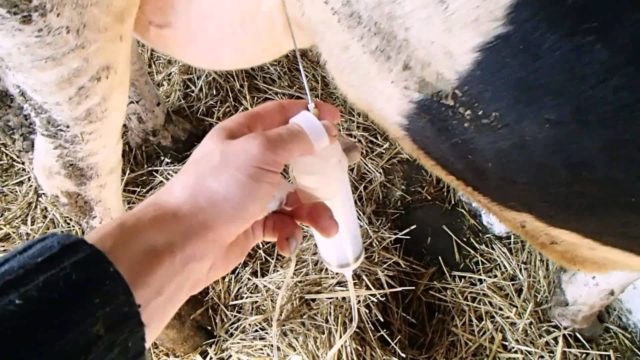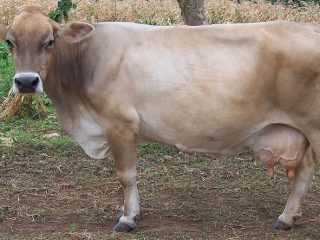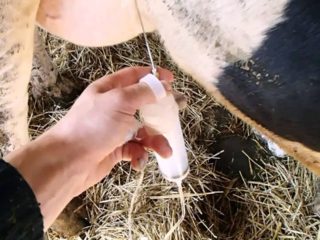Content
Experienced farmers often need to treat a bruised cow's udder. This is a common occurrence that almost every cattle owner has encountered. Despite the external frivolity of the disease, it is fraught with many dangers and can lead to unpleasant consequences.
Symptoms of a bruised udder in a cow
With a mechanical effect on the udder in the form of a bruise, a noticeable hematoma appears at the site of the impact. It has a characteristic color due to damage to the blood vessels and, in some cases, the lymph nodes. This provokes hemorrhage into the parenchyma, after which the blood enters the milk canals. This gives the milk a pink color, sometimes with distinct clots. It becomes unusable.
If the remaining parts of the udder are not damaged, then the milk obtained from them can be used - for food or for commercial sale.
A bruised udder in a cow has the following manifestations:
- in the lobe that has suffered, bruising, noticeable abrasions, and in some cases - seals form;
- a local increase in temperature is observed in the damaged area;
- there is swelling of the udder and nipple;
- milk is difficult to milk, in the presence of blood clots in the cysteral canal, milking through it becomes impossible due to local overlap.
To eliminate the symptoms of a bruised udder in a cow, a special treatment is prescribed, which cleans the nipple cistern, lowers the temperature, relieves swelling and stimulates the resorption of the hematoma.
With untimely or ineffective therapy, such a bruise of the udder in a cow can lead to mastitis, which requires more careful drug treatment.
To avoid such negative consequences, the farmer must adjust the diet and drink of the animal. His ration of fluids and succulent feeds is cut to reduce body fluids and subsequently relieve puffiness.
Why are udder injuries dangerous for a cow?
On the surface, it may seem that bruises on the rear right lobe of the cow's udder or other quarters are completely harmless. However, in reality, the consequences of such an injury can promise unpleasant consequences. For example, it threatens to decrease milk production. If there is an extensive hematoma, then its contents are encapsulated, due to which the glandular tissue replaces the connective tissue. Thus, the milk tank stops working normally.
Treatment of a bruised udder in a cow
The sooner the owner of the animal begins to treat a bruised udder in a cow, the less the likelihood of complications. To reduce puffiness and restore normal blood circulation in the area of the damaged area, the site of the injury is abundantly lubricated with iodine. It heals external abrasions and helps blood clots disperse evenly.
Over time, microtraumas that have formed at the site of the injury will begin to disappear. Iodine also has an antiseptic effect and prevents infections, fungi and other pathogenic microflora from entering the breast.
The injury itself is treated as follows:
- the first 2-3 days after the appearance of a hematoma, a heating pad with ice is applied to it;
- puffiness is removed with a mixture of clay and 9% vinegar, the composition is brought to a state of gruel;
- any intense mechanical impact (including massage) is prohibited;
- on the 4th day, the damaged area begins to warm up with the help of warming heating pads, ichthyol and camphor ointment;
- also, compresses from streptocidal ointment and Levomekol are applied to the site to accelerate the healing of mechanical injuries;
- in some cases, irradiation with an ultraviolet lamp is prescribed.
When blood clots accumulate in the teat canal, it becomes necessary to remove them for effective milking. To do this, it is regularly washed with potassium permanganate or a solution of baking soda (alternatively, you can use peroxide).
If local treatment of a bruised udder in a cow does not give any results, the hematoma is surgically opened. This is necessary to completely cleanse the area from blood clots. The damaged blood vessels are then ligated. An open wound also needs special care:
- intramuscular administration of antibiotics;
- external use of healing drugs, ointments and compresses;
- covering an open wound with a sterile dressing;
- fixing the dressing with a special bandage.
Prevention of udder injuries
Most often, with stall maintenance, bruises occur due to regrown hooves. Therefore, it becomes necessary to cut them off in a timely manner, although this does not completely exclude the possibility of damage.
Also, as a preventive measure, it is necessary to ensure that cattle with sagging udders or elongated teats do not enter the stall. It is necessary to provide free accommodation of animals in the stall, on average up to 5 m wide for one cow.
When using machines for machine milking, it is necessary to strictly adhere to the order of preparation and procedure. With a massive transition from manual milking to machine milking, the following operations are mandatory:
- animals are divided into groups according to predetermined characteristics;
- milkmaids and mechanics are trained in the correct operation of the equipment;
- all milking areas and machines are pre-prepared.
For the prevention of udder injuries, veterans are involved, who draw up special programs for the treatment of premises and animals.
Conclusion
It is quite easy to treat a bruised udder in a cow, because a blow to the mammary gland is one of the most common injuries, which most often occurs in summer in open pastures. During this season, farmers should be especially careful to inspect the udders of animals in order to quickly relieve symptoms and begin therapy if an injury is detected. Careful care will help keep your cows healthy and milk abundant.











